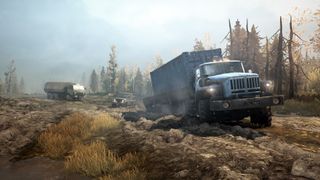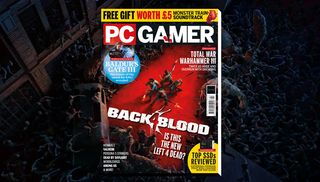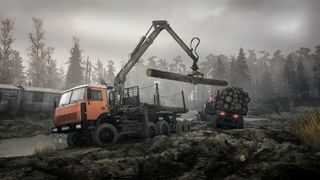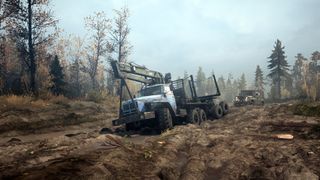How one man's love for spinning tyres birthed Mudrunner
We chat with Mudrunner's creator about how the wonderfully mucky world of trucks can feel like home.


This article first appeared in PC Gamer magazine issue 355 in April 2021, as part of our 'Positive Influence' series, where every month we chat to a different developer about the inspirations and unexpected connections behind their work.
There's nothing quite like Mudrunner for cooling the blood, to paraphrase the classic Flanders and Swann number. There's something meditative about plunging a truck into brown soup, then spending ten minutes wiggling the left stick and attaching winches to trees in a gradual and patient attempt to free your wheels from the quagmire. It's a premise that would be considered ponderous or perverse by conventional game design standards, which hold that players should be swept along and kept busy at all times. But Mudrunner didn't come from conventional game design—it came from the mind of Pavel Zagrebelnyy.
Zagrebelnyy was born in St Petersburg, Russia, the world's northernmost metropolis. It was a grounding that would give him access to people, infrastructure, and ultimately work at an internationally known game studio. But it also gave the young Zagrebelnyy reams of strange, swampy countryside to explore. When he was at home, he played with toy trucks in his sandbox; when he was outside, he watched real trucks and excavators work in the fields.
In particular, Zagrebelnyy fell in love with the super-heavy mechanical monsters of the Soviet era. These were trucks that met hostile terrain with equal and opposite hostility. To Western sensibilities, they resemble the invented vehicles of Gerry Anderson's Thunderbirds—highly specialised tools, running on tracks or enormous wheels, with irregular silhouettes and deafening calls. "These types of vehicles are simply what I grew up around, you could see them everywhere," says Zagrebelnyy. "They looked normal to me. But later I realised they seemed strange and exotic to people in other areas of the world.

"I found them to be inspiring. Think about the military vehicles—they have nothing extra. Everything serves a practical purpose. And when you hear their monstrous engines roar, you feel their power. You can't help but be impressed." Further inspiration came from a teacher, who awoke Zagrebelnyy to the wonders of physics. That led to a degree in computer software engineering, and later a job as a graphics programmer at Saber Interactive. There he worked on Halo's anniversary remake, gaining the experience needed to build something on his own.
Keep on truckin'
Mudrunner—initially called Spintires—began as a side project that melded Zagrebelnyy's lifelong obsessions: volatile physics and misshapen trucks. "The hobby mindset, versus a commercial one, allowed me to shape the game in the exact form I wanted it to be," he says. "I just kept building something I loved."
The hobby mindset, versus a commercial one, allowed me to shape the game in the exact form I wanted it to be. I just kept building something I loved.
Pavel Zagrebelnyy
Even for Zagrebelnyy, situated in a city at the edge of civilisation, the wilderness of Mudrunner holds a certain romance. "Unfortunately, I haven't even travelled that much in Russia, it is such a vast country," he says. "Certainly, the frontiers capture the imagination. Siberia evokes something special in the minds of everyone. It almost feels like a different planet, yet people live and work there. And the vehicles you see in Mudrunner, they feel at home."
The hobby became a huge solo success, introducing the world to Zagrebelnyy's influences. Today he still lives in St Petersburg, and still works at Saber Interactive, who led development on last year's Snowrunner. "I played a different role on Snowrunner," says Zagrebelnyy. "While I contributed as a consultant, it was a much more ambitious project, with higher production values and efforts to make the gameplay more accessible. It was so much bigger than just me."
The biggest gaming news, reviews and hardware deals
Keep up to date with the most important stories and the best deals, as picked by the PC Gamer team.

Zagrebelnyy's transfer of creative control turned out to be a good thing for Snowrunner, which benefits from clearer objectives and a Ubisoft-esque open world. "I can't speak for Saber, but perhaps Snowrunner's exploration structure was simply a natural evolution," he says
The game's engine, however, hasn't been swapped out—it remains the product of Zagrebelnyy's passions, even as he takes on a peripheral role. "Personally, I don't want to make videogames that provoke anger, jealousy, or other negative emotions," he says. "I like the balancing of traditional challenges, the integration of physics and the feel of the wilderness. I'm proud to showcase the technologies in the game while giving players something that is fun in a new way, perhaps even peaceful."
Most Popular


